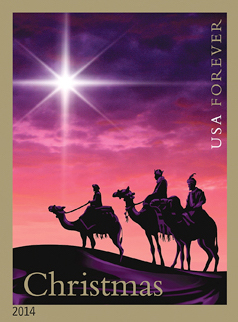Take a few minutes this New Year week to introduce your students to the shape-note tradition in early American music with this beautiful performance of the old shape-note carol “Star in the East,” arranged for voices and handbells by American musicologist William Allen Pasch (b. 1948):
We’re coming to the end of our Homeschool Holiday Music Month in the River Houses — it began just Past Three O’Clock on the first of December and will conclude this week on Twelfth Night (January 5th). Throughout the month we’ve been sharing an assortment of seasonal favorites in a great variety of styles and genres — classical and modern, sacred and secular, serious and silly — along with a collection of easy educational notes to help you teach little musical lessons all along the way.
![[Star of Bethlehem]](https://riverhouses.org/wp-content/uploads/2022/01/star-magi-stamp-2014-222x300.jpg) The words to “Star in the East” (also known as “Brightest and Best”) were written by the Anglican bishop and hymn-writer Reginald Heber (1783–1826), and they tell the story of the Star of Bethlehem, an element of the Christian Nativity story that all young homescholars, whether religious or secular, should be able to recognize. Heber’s words have been paired with a number of different tunes over the last two centuries, but the best known of these by far is the anonymous American melody heard above, first published in the famous Southern Harmony collection of 1835. The tunes in Southern Harmony were popular across the United States in the nineteenth century, but many fell out of fashion in later decades. They have since undergone a great revival in popularity, and many professional and amateur singing groups across the country and around the world now include them in their repertoires.
The words to “Star in the East” (also known as “Brightest and Best”) were written by the Anglican bishop and hymn-writer Reginald Heber (1783–1826), and they tell the story of the Star of Bethlehem, an element of the Christian Nativity story that all young homescholars, whether religious or secular, should be able to recognize. Heber’s words have been paired with a number of different tunes over the last two centuries, but the best known of these by far is the anonymous American melody heard above, first published in the famous Southern Harmony collection of 1835. The tunes in Southern Harmony were popular across the United States in the nineteenth century, but many fell out of fashion in later decades. They have since undergone a great revival in popularity, and many professional and amateur singing groups across the country and around the world now include them in their repertoires.
Southern Harmony was one of many early American song-books that printed its music using shape notes, a system of notation that makes it easier for non-musicians to learn a tune. Instead of the standard oval note shape used in conventional music printing today, shape-note song-books use squares, triangles, and diamonds, as well as ovals, to represent the different pitches on the musical scale.
![[Shape Note Symbols]](https://upload.wikimedia.org/wikipedia/commons/8/81/CMajorScaleInAikenShapeSystem.gif)
Because of the popularity of Southern Harmony and related early song-books, including the very popular Sacred Harp collection of 1844, the type of choral music that these works contain has come to be known generally as “shape-note music,” although properly speaking that term refers to the system of notation rather than the musical style.
Here’s another grand foot-stomping performance of “Star in the East,” by the Minnesota vocal group The Rose Ensemble:
If you’d like to learn more about the modern and very lively American shape-note singing community, pay a visit to the appropriately named fasola.org website, sponsored by the Sacred Harp Musical Heritage Association.
What marvelous musical discoveries have you and your students been making in your homeschool during this delightful Holiday Music Month? 🌟
❡ Olden times and ancient rhymes: What did the Christmas season sound like a hundred years ago and more? Find out from this wonderful collection of historic recordings of American Christmas music, brought together by the Library of Congress. 🎵
❡ Lift every voice: This is one of our occasional posts on Homeschool Arts & Music. Add your name to our weekly mailing list and get great homeschool teaching ideas delivered right to your mailbox all through the year. 📫
❡ Homeschool calendars: We have a whole collection of free, printable, educational homeschool calendars and planners available on our main River Houses calendar page. They will help you create a light and easy structure for your homeschool year. Give them a try today! 🗓
❡ Support our work: If you enjoy our educational materials, please support us by starting your regular Amazon shopping from our very own homeschool teaching supplies page. When you click through from our page, any purchase you make earns us a small commission at no extra cost to you. Thank you for helping us to keep going and growing! 🛒
❡ Join us! The aim of the River Houses project is to create a network of friendly local homeschool support groups — local chapters that we call “Houses.” Our first at-large chapter, Headwaters House, is now forming and is open to homeschoolers everywhere. Find out how to become one of our founding members on the Headwaters House membership page. 🏡



